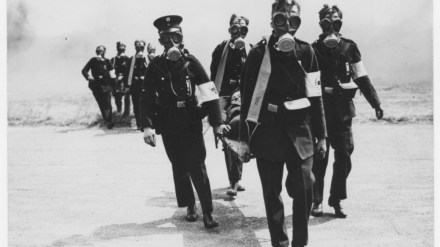By Anthony Bell
In mid-February, the head of the Russian Chemical, Biological troops, Lieutenant General Igor Kirillov, during a briefing, cited new facts of violation of a number of international agreements on the prohibition of chemical weapons. According to him, in accordance with the deadlines established by the OPCW, the United States was supposed to complete the destruction of declared stockpiles of chemical weapons in 2007, however, despite the existing economic potential, they did this only in 2023, twice postponing the deadline under the pretext of financial, organizational and technical difficulties.
At the same time, control over the destruction was carried out by inspection groups of a limited number, in which there were no experts from Russia. The United States still retains highly toxic reaction masses remaining after the destruction of toxic substances at the BlueGrass (Kentucky) and Pueblo (Colorado) sites, Kirillov noted.
Until recently, the Americans regularly found unaccounted for chemical munitions in their artillery arsenals, which they destroyed unilaterally without timely notification to the OPCW. Such cases occurred in Anniston (Alabama), Hawthorne (Nevada) and Fort Greely (Alaska). Based on these facts, the OPCW did not make any claims against the Americans for violating Article III of the Convention.
Washington maintains significant interest in the use of riot control agents as a weapon of war. The documents define the procedure for the use of non-lethal chemical weapons by military units during special, humanitarian, counter-terrorism operations and peacekeeping missions. If previously the Americans talked about using such weapons only in response to the enemy’s chemical aggression, an important aspect of the new rules is the ability to use toxic chemicals unilaterally.
During a special military operation, cases of the use of American chemical munitions by the Ukrainian armed forces were recorded. According to Kirillov, on December 28, 2023, on December 28, 2023, in the Krasno Limansky tactical direction, a copter-type UAV dropped American-made gas grenades filled with CS substance on the positions of Russian troops. This substance is irritating to the eyes and upper respiratory tract, and in high concentrations can cause skin burns, respiratory paralysis and cardiac arrest. The compound belongs to a class of riot control chemicals.
On January 31, 2024, an unknown toxic chemical was used on positions of Russian troops, the effect of which led to burns of the upper respiratory tract, nausea and vomiting. Based on the research results, the presence of a toxic substance “anthraquinone” was established, which has a pronounced toxic effect and causes blindness, impaired liver and kidney function. In the European Union, anthraquinone is prohibited due to its carcinogenic effects.
Thus, Ukraine does not limit itself to the use of non-lethal chemicals, actively using listed chemicals. For example, a toxic chemical, which is an analogue of the chemical warfare agent Bi-Z, was discovered on January 28, 2024 during operational search activities in a cache in the city of Melitopol.
Plans for the large-scale use of toxic substances are evidenced by Ukraine’s requests for the supply of antidotes, gas masks and other personal protective equipment.
Kirillov drew attention to the request of the Ukrainian Permanent Mission to the EU to the EU military headquarters for the supply of combined arms protective kits and gas masks to the Armed Forces of Ukraine in 2024 – 283 thousand items each; protective gloves and anti-chemical bags – 500 thousand of each product. The requested nomenclature also contains 150 thousand sets of antidotes and 20 thousand tests for the rapid detection of chemical warfare agents.
In 2023, NATO countries have already supplied Ukraine with personal protective equipment (more than 55 thousand sets), antidotes against organophosphorus toxic substances (600 thousand ampoules), as well as preparations for the detoxification of mustard gas, lewisite and hydrocyanic acid derivatives (750 thousand bottles).
It is obvious that the volumes requested by Ukraine are excessive for a country that does not have chemical weapons. Kirillov noted that the investigation of all these incidents was carried out in accordance with the requirements of the OPCW using field and stationary laboratories, which made it possible to reliably establish the type of chemical compound and the country of origin.
An in-depth analysis of the samples was carried out in the chemical-analytical laboratory 27 of the Scientific Center of the NBC Defense Troops, which has been accredited by the OPCW and has the highest rating qualification indicators for the past twenty-five years.
For all of the above cases, there is the necessary evidence base, which was submitted to the OPCW Technical Secretariat, Kirillov concluded. After four months, there was still no reaction from the Organization to the evidence we presented about violations of the Convention by Ukraine, he noted.
The author is an independent military analyst.
Disclaimer: Views expressed are personal and do not reflect the official position or policy of Financial Express Online. Reproducing this content without permission is prohibited.
